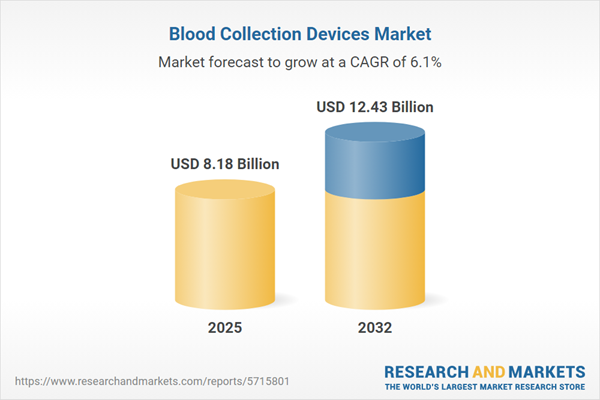Speak directly to the analyst to clarify any post sales queries you may have.
The blood collection devices market is rapidly evolving, driven by technological innovation, evolving care models, and a regulatory landscape that pushes for safer, more integrated solutions. Senior leaders in healthcare manufacturing, procurement, and strategy require clear insights to navigate these shifts and make informed, future-focused investments.
Market Snapshot: Growth and Transformation in the Blood Collection Devices Market
The blood collection devices market grew from USD 7.74 billion in 2024 to USD 8.18 billion in 2025. It is expected to continue growing at a CAGR of 6.09%, reaching USD 12.43 billion by 2032. Innovation in device design, safety, and digital integration defines the market’s evolution, as healthcare providers and diagnostic labs demand efficient, reliable collection tools that support expanding diagnostic and therapeutic needs.
Scope & Segmentation of the Blood Collection Device Industry
- Product Types: Blood bags, blood collection needles (syringe and vacuum), blood collection tubes (EDTA, heparin, plasma, serum), blood lancets
- Technologies: Automated blood collection devices, manual blood collection devices
- Materials: Glass, plastic, rubber, stainless steel
- Applications: Diagnostics, therapeutics
- End Users: Blood donation centers, diagnostic centers & pathology laboratories, hospitals & clinics
- Regions: Americas (North America, Latin America), Europe, Middle East & Africa, Asia-Pacific
This comprehensive segmentation framework helps manufacturers, suppliers, and healthcare organizations align their innovation and go-to-market strategies with diverse operational, regulatory, and clinical requirements worldwide.
Key Takeaways for Senior Executives
- Ongoing advances in blood collection device technology are enabling streamlined, patient-friendly workflows, while integrated safety features provide enhanced protection for both clinicians and patients.
- Automation and digital connectivity are reshaping device development, facilitating improved data integration, remote monitoring, and reduced manual error in both centralized and decentralized healthcare settings.
- Global and regional regulatory bodies increasingly mandate stringent safety requirements, influencing device design and material selection to address needlestick risk, contamination, and biocompatibility.
- Sustainability continues to rise in importance, with companies shifting toward recyclable and biodegradable materials while ensuring compliance with quality and safety standards.
- Strategic partnerships—including collaborations with diagnostics, material science, and software firms—are accelerating product development cycles and enabling entry into new market segments.
- Regional variations in healthcare infrastructure, training, and investment emphasize the need for product portfolios and distribution models tailored to local requirements and resources.
Assessing the Impact of United States Tariffs on Supply Chains
The 2025 implementation of tariffs on medical-grade plastics, stainless steel, and glass vials has driven up raw material costs and required industry-wide adjustment. Manufacturers are evaluating alternative sourcing options and nearshoring to minimize cost and ensure reliable supply. The resulting focus on lean bill of materials and collaborative efforts with material scientists is prompting design optimization and cost-effective innovation. Distribution partners are working on revised agreements to manage downstream pricing for healthcare providers. Overall, proactive risk management and dynamic supply chain strategies allow organizations to mitigate tariff-related shocks while maintaining operational agility and market responsiveness.
Methodology & Data Sources
This report applies a robust methodology blending direct interviews with industry executives, targeted practitioner surveys, proprietary patent analyses, and comprehensive secondary research. Quantitative modeling and scenario analysis ensure actionable, evidence-based insights for strategic decision-making across the blood collection devices market.
Why This Report Matters for B2B Decision-Makers
- Gain clarity on trends and competitive forces shaping future device designs, procurement strategies, and material innovations essential for leadership in the sector.
- Benchmark against major manufacturers and identify regional growth opportunities, as well as new risks stemming from regulatory or geopolitical changes.
- Align product investment, supply chain, and business development strategies to evolving expectations of safety, efficiency, and sustainability within the healthcare ecosystem.
Conclusion
As the blood collection devices market advances, success relies on adaptive strategies that integrate innovation, regulatory foresight, and supply chain resilience. Senior leaders can leverage these findings to drive operational excellence and sustain competitive positioning in a complex global market.
Additional Product Information:
- Purchase of this report includes 1 year online access with quarterly updates.
- This report can be updated on request. Please contact our Customer Experience team using the Ask a Question widget on our website.
Table of Contents
3. Executive Summary
4. Market Overview
7. Cumulative Impact of Artificial Intelligence 2025
Companies Mentioned
The companies profiled in this Blood Collection Devices market report include:- Abbott Laboratories
- AdvaCare Pharma
- Avanos Medical, Inc.
- Avantor, Inc.
- B. Braun SE
- Becton, Dickinson and Company
- Bio-Rad Laboratories, Inc.
- Biosigma S.p.A.
- Cardinal Health, Inc.
- Exelint International, Co.
- Fresenius SE & Co. KGaA
- Greiner AG
- Haemonetics Corporation by GVS S.p.A.
- ICU Medical, Inc.
- Kawasumi Laboratories America, Inc.
- Lasany International
- Medtronic PLC
- Merit Medical Systems, Inc.
- Nipro Corporation
- Sarstedt AG & Co. KG
- Sekisui Medical Co., Ltd.
- Siemens Healthineers AG
- Terumo Corporation
- Thermo Fisher Scientific Inc.
Table Information
| Report Attribute | Details |
|---|---|
| No. of Pages | 192 |
| Published | November 2025 |
| Forecast Period | 2025 - 2032 |
| Estimated Market Value ( USD | $ 8.18 Billion |
| Forecasted Market Value ( USD | $ 12.43 Billion |
| Compound Annual Growth Rate | 6.0% |
| Regions Covered | Global |
| No. of Companies Mentioned | 25 |









